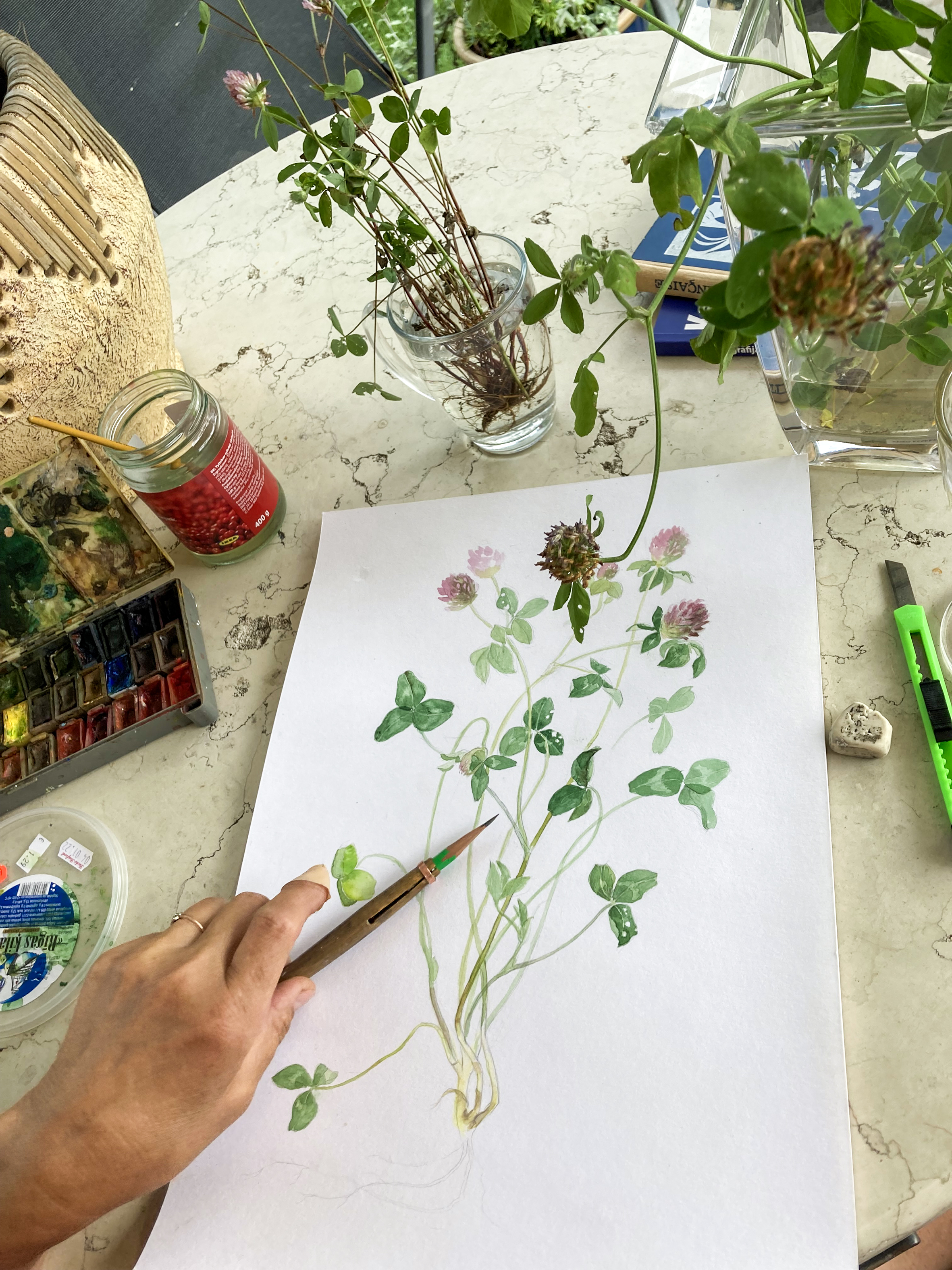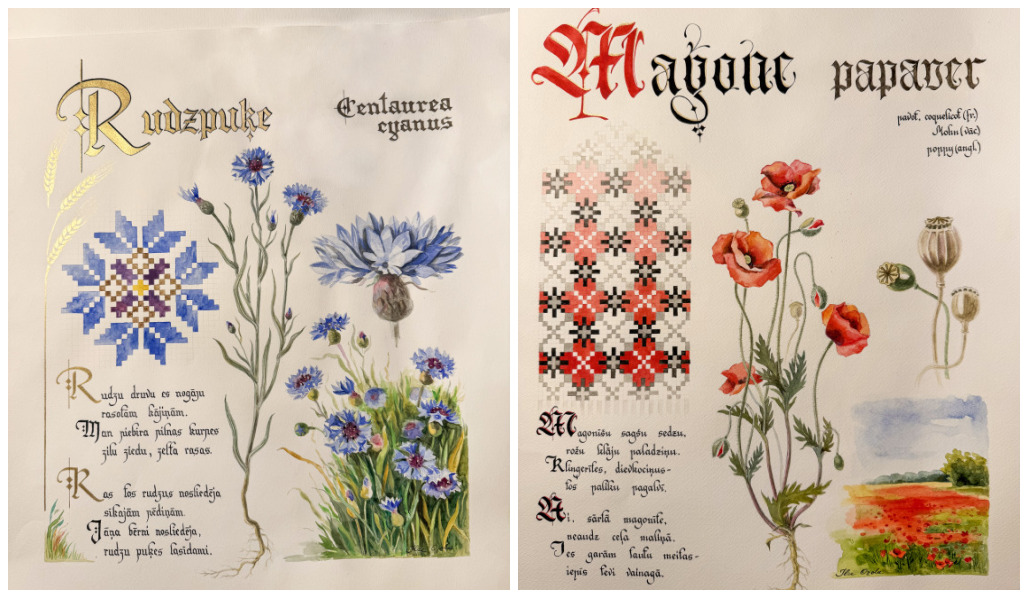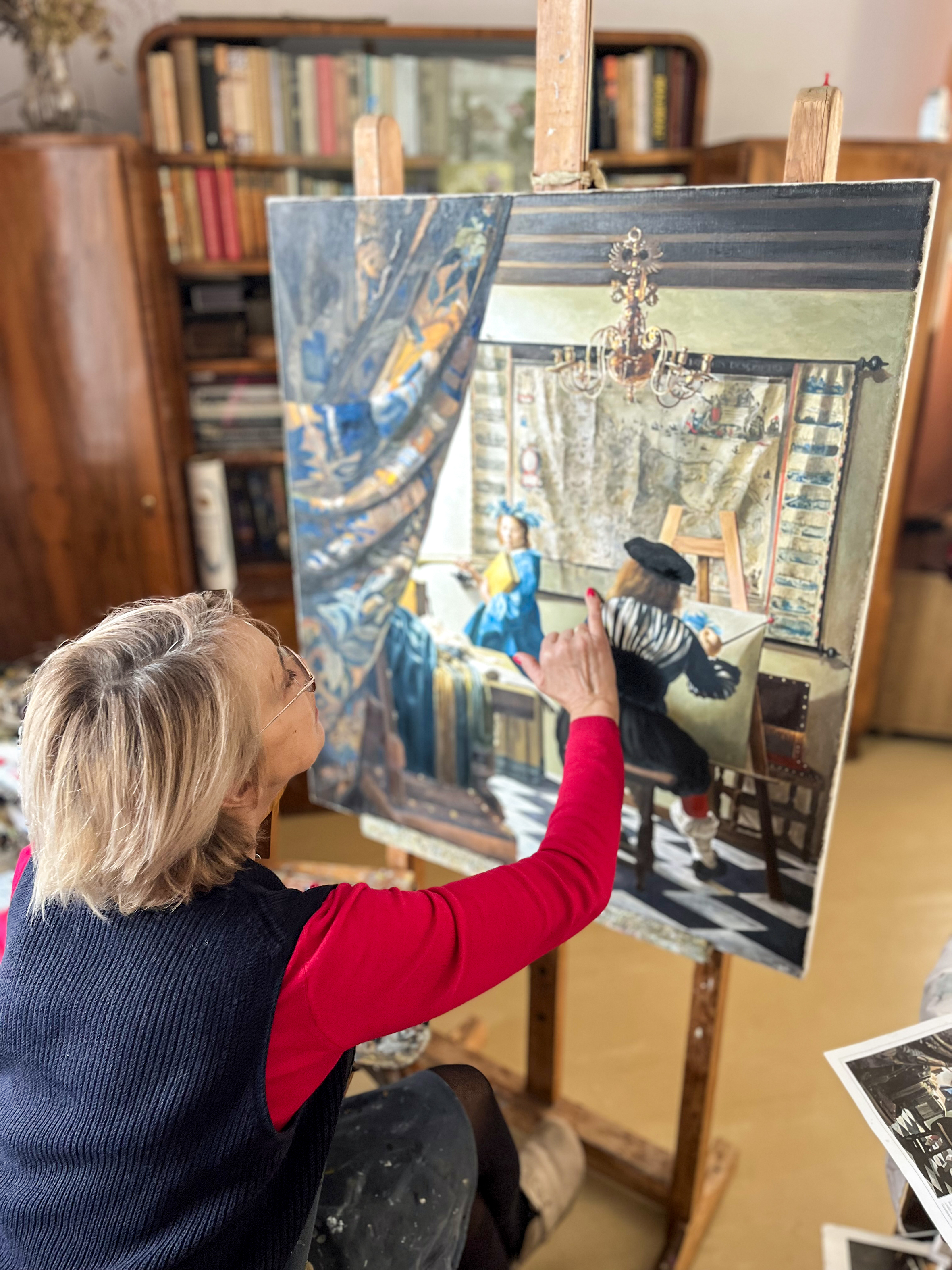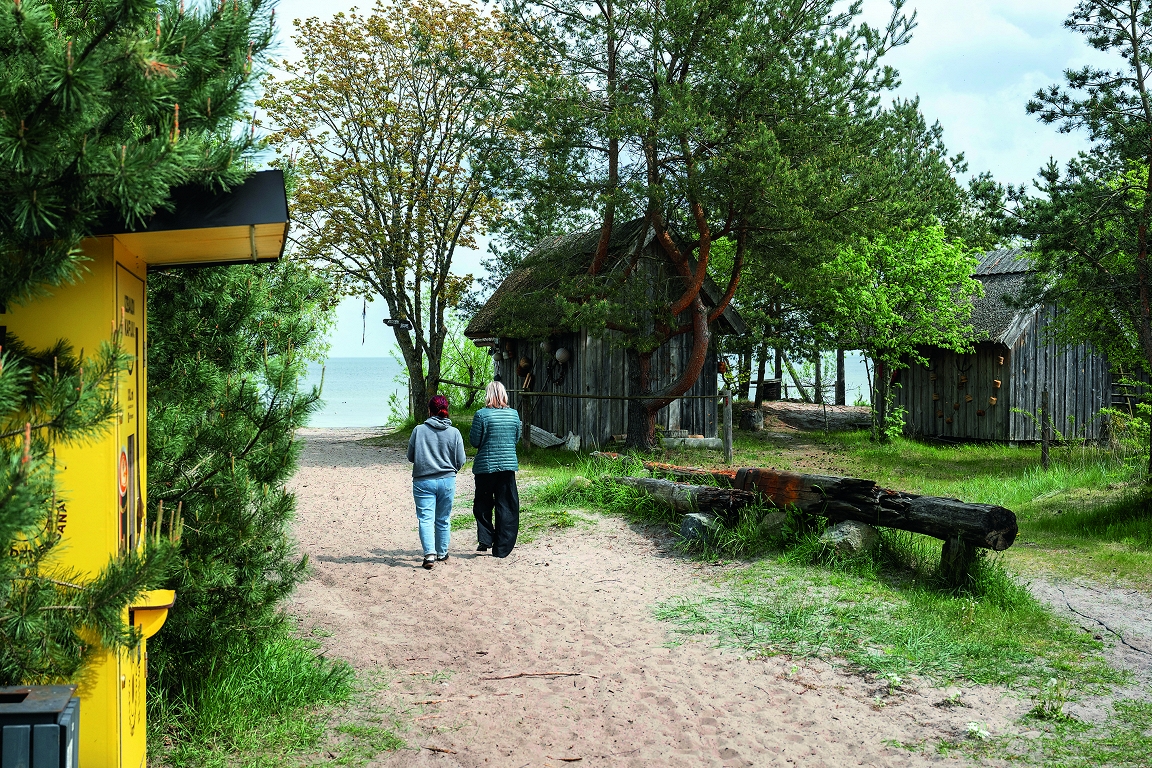The sun was dancing in the dandelion meadow. Interview with artist Ilze Ozol / Day

It all started with the fact that I was working on an interior where each of the eight rooms in the ceiling was intended for a Latvian ornament with the motif of another flower – exhibitions Latvian botanical drawings The idea is revealed by artist Ilze Ozola. The exhibition will be on view at Aspazija’s house in Dubulti until May 3. A moment of true rays of true harmony and filigree hand work.
Everyday Ilze Ozola is an interior decorator and forms large -scale ceilings and wall paintings in glaze technique. Also marble, small architectural forms of gold, wood imitation and wall decorative paint.
When you have a stack of photos taken with them, the artist shows the story of the captured « Flower Interior »: « Here on the ceiling there are cornflower, poppy, violet and not forgotten motifs. Next, here’s the dandelion. It was a huge job. ceiling. «
How did the first impulse grow up to an exhibition in Aspazija’s house when creating a flower interior?
When I made interior decoration with flowers, I remembered the beautiful botanical drawings of England and began to think that I could create similar drawings with Latvian added value. I wanted to carry out a smaller painting in the ornamentation of the motifs I had already been found. This was the idea of a folk song. We have all learned folk songs in our time, but now I discovered how poetic is they! « Saulīte danced in dandelion meadow / golden shoes » – Spring immediately, when everything begins to bloom and the human soul cheers. The authors of folk songs are anonymous, and we know how difficult it is to find the exact expression to say emotions in words, but in the folk song it sounds so sophisticated poetically. The idea was also spelled out of the excitement of Latvian botanical drawings that took over me while traveling through Europe. I have been lucky enough to work in a rich historic home in London. There I was delighted with the Botanical drawings of Victoria, which, as small works of art, decorate English interiors. In the early 1990s I worked in Latvian ownership in the Abrene Castle in the Loire Valley in France. Andrejs Rītiņš – Mārtiņš Rītiņš brother – there was a decorative restoration. There I learned to gold and marble. After that, I worked a bit in London. I liked everything historic and pristine there. I am also quite classic in my painting.
One page has a drawing of the plant, its pattern and folk song. How did you divorce for such a composition?
I have long been fascinated by calligraphy. Of course, I was living in glasses early in my youth. This gothic pattern is very captivating, also easy to learn. I studied medieval illuminations at the British Museum. There were open books there and I was able to study the beauty of the letters, the gold. Getting into the richness of the most famous museums, the creativity of medieval book illustrators, virtuosity, sophisticated aesthetics and leisurely patience are delighted. On the one hand, I can be blamed for my botanical drawings are not really Latvian, but we are already heirs to all who have come from Western European culture and what we have learned over time. Why not? I put it together in my compilation.
« I tried to keep the botanical approach. Plants are natural, unhooked, with the entire life cycle, « says Ilze Ozola. Photo from personal archive
How much do these drawings have accuracy, how much – your creative imagination and interpretation?
I try to take the plant in nature and explore, sketch and paint it myself. You can already mean everything on the Internet, but then it won’t be my job. That is the joy of the studio.
Are the plants seen and observed in different places?
Almost every morning I go with a dog to the forest. Well, linden is everywhere, including cornflower and dandelion. And the garden full of different plants.
Is the dandelion in Latvia and the dandelion in England?
I think not. Also in Magones in France, where I painted red poppy fields. It seemed that the meadow had a red color. The small drawing that I have at the Magone at the exhibition comes from France a bit. However, in Latvia you can find gorgeous poppy fields.
Did you choose to portray the plants found in Latvian folk songs?
Yes, first of all, those who are sung in folk songs. Magone and cornflower, then came the dandelion. These works came first to me. After that, I started to find others in folk songs. Together in this series there are twelve leaves with different plants. Of course, I also want to make an oak – a compliment to the man (director Arnis Ozols – Ua).

Why was it important for you to draw the root of the plant?
I tried to keep the botanical approach. There are Latin names, some works also English, French, German. It is not consistent: if I do not go in the composition, then oh, let it remain. The plants are natural, unmarried, with the entire life cycle. The wild strawberry has a flower, a berry and a dried brown leaves at the same time. Yes, the strawberry page was the last thing I was drawing, but how I was tormented by the zaptm bread and the jar! Well, how do you paint it zaptmaizi?! It was a provisional time and I had a sick mom. From morning to evening in the dark of winter, I was able to knock on electric lighting. Patience is a malfunctioning – I can sit and tease for hours.
Do you work with watercolor colors?
Yes, there is watercolor in this series of botanical works, but I paint my paintings in oil.
What are your tools?
As much as fine brushes. Also, flat feathers for calligraphy. There is also the gilding I work with in my profession and used in the interiors when I make rosettes at the lamps or eaves.
In the old centuries, such drawings replaced the photo. Do you think these drawings also have a documentary testimony?
No, documentary meanings such as the Victorian world of newly discoveries and explorations, of course, no longer have. Now all newly discovered plants are digitized. I think my works are awareness of Latvianness. In fact, these are not exhibition works, but I wanted to introduce them to the audience. They are meant for people in their interior – living room, kitchen or dining room. These are intimate works. They are best revealed in the group – two or three together. Only then do they shine in all their diversity. They have sincerity and simplicity. We Latvians, too, are proud to contribute to the unique folk songs and glove writings we own for cultural heritage. Natural color, bright colors, brilliant glow and clear purity are also a poetic portrayal of human dais. Gold dew, silk flowers, Sidraba leaves. It was a series of works that encourage you to understand where the Latvian writings came from the characteristic color combination, graphic rhythms, ornament.
How do you feel nature outside this exhibition?
Nature is very important to me. I live in Purvciems’s house where my mom was born. Bikernieki forest around – in my childhood there were meadows with ditches, tadpoles and frogs. The brother was born late, I was a long time and I was delaying the time, listing every flower that blossomed in the garden – the first one, the second one. Now I go out in the garden – o, so much bloom!
When it comes to paintings, I have mostly painted flowers and landscapes. I paint a rich, bushy flower arrangements that can be arranged at each time of the year. Winter bouquets have straws, bent, lemonia, blue pendants, etc. I learned for two years in a youngest Japanese flower arranging Sogecu school, the youngest of all the schools of the Icebana and is known for its looser. Ikeban has played an important role in my sense of aesthetics.
Please tell me about copying the work of the old masters, which you are doing. The exhibition of your copies will be on view in Bauska Castle soon. How were you interested in it?
By studying at the Academy of Arts, copying is a mandatory work. Students, of course, are formally treated. Something on the view is bent. Copying is time consuming and a normal student never has time to sit for days. That is what I can afford now. After years of study, several unfinished copies had accumulated, which had already been viewed. I think a lot of work is invested, you should force and make as well as possible.
You have told you that Vermy is particularly close to you. Have you discovered the special smoky and clouds of Vermaer?
No, there is no special smoky. Rather, as art scientists say, one might think that Verma has worked with Camera Obscura. His paintings come with light stitches that could be fixed with the camera. Why is Verimalian close to me? I am also an introverted person. I have enough for myself – in my nature quiet, in peace all the time. For Verse, a person in the interior is actually a stinking set of quiet. The girl pours milk or water. I like its intimacy, leisurely, sunshine over the walls and objects in the room. There is peace and harmony. This is very close to me, and I see it in Verse’s paintings.

From what do you copy old master paintings? Drive to museums to study the originals?
Complete, of course, from reproductions, because this work is very time consuming. However, I am very helped by a computer screen where I can increase and explore every detail. I have seen almost all the works I have copied in the original – London, Paris, Vienna and elsewhere. In Amsterdam, she was lucky to get directly to the Vermaer Exhibition. Works from America and France were brought there. It was a pleasure to compare and evaluate how I was successful. I read the book by Imants Lancman, and he is so much about Vermy. It is a wonderful and inspiring book (Ineta Meimane. Witness of Providence. Talks with Imants Lancman, publishing house The Book of the Day – UA). I have copied Peter Bregel’s oldest paintings Hunters in the snow and Babel Tower.
What are the copyright rules in making copies of old masters?
Everywhere I write that it is a copy. I have heard that copies should not be made in size 1: 1, but it has not been tested.
What happens when you go into work so much? Can you access Verse as a person in this process and imagine how he worked?
Vermet is understandable to me from the way he is isolated from the outside world in his workshop. It can be seen in his work The artist in his workshop. I have already been working in the same way – no one smooth, overwhelmed by my thoughts, with dreams and intentions in my head. I started my oil paintings in nature, but finished in the workshop. Fine brushes, joy of colors, delay and tremendous patience.
More about the artist: Instagram account @ilze_un_otas
Ilze Ozola
Exhibition Latvian botanical drawings
Aspazija’s house will double up to 3.V






